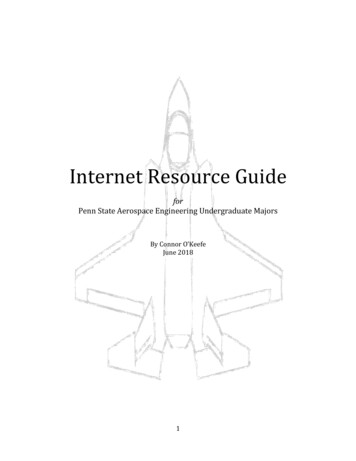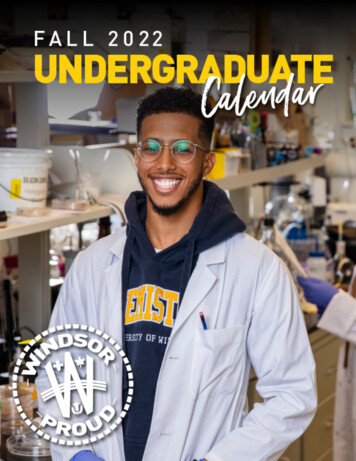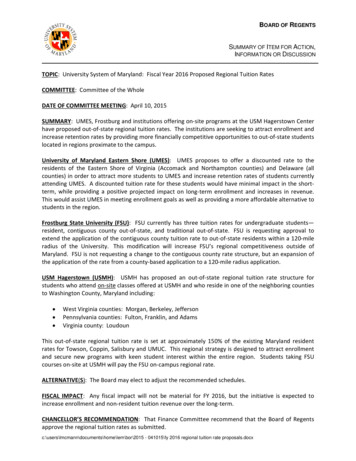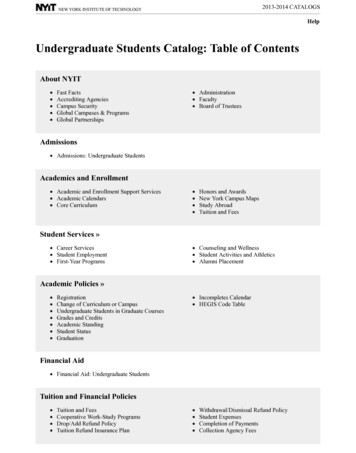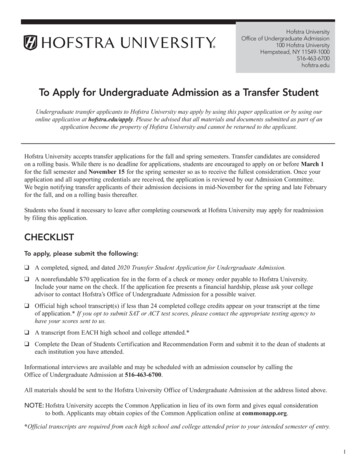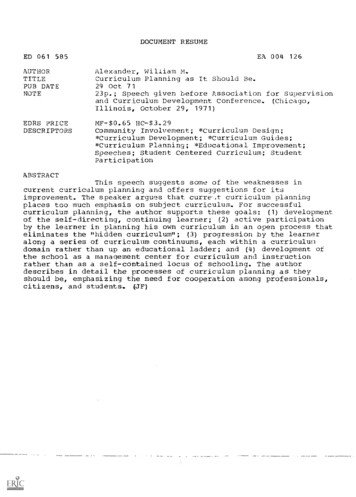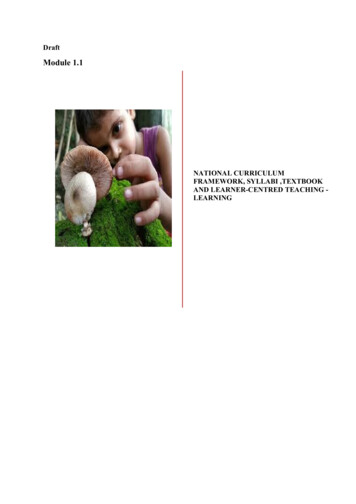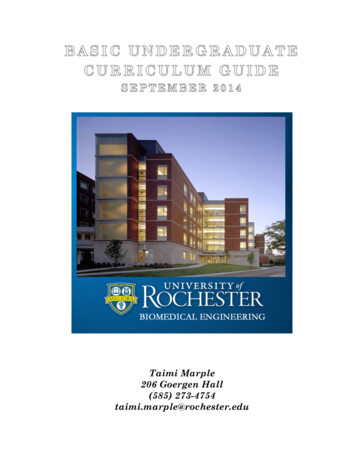
Transcription
BASIC UNDERGRADUATECURRICULUM GUIDESEPTEMBER 2014Taimi Marple206 Goergen Hall(585) 273-4754taimi.marple@rochester.edu
BME ADVISORS2014Benoit, DanielleLaurel CarneyDalecki, DianeSeidman, ScottGoergen 308MC 5-6418Goergen 310MC ochester.edusiedman@bme.rochester.edu2015Choe, RegineMcGrath, JimNam, Jong-HoonSeidman, ScottMC 6-7614Goergen 306HopemanMC 6-74233-43743-54893-45553-2122regine choe@urmc. ey, MarkLerner, AmyLuebke, AnneWaugh, RickGoergen 317Goergen 307MC 6-8547Goergen eduamy.lerner@rochester.eduanne 17Awad, HaniBrown, EdwardGdowski, GregMcAleavey, StephenMC1-8453MC 5-6224AGoergen 218Goergen 3093-52683-59185-25805-7768hani awad@urmc.rochester.eduedward stephen.mcaleavey@rochester.edu
BME PRIMARY FACULTYChair of the DepartmentRichard E. Waugh, Ph.D. (Duke) Professor of Biomedical Engineering, of Pharmacology and Physiology, ofBiochemistry and Biophysics, and of Mechanical EngineeringResearch Area - Mechanical and thermodynamic properties of biological membranes; cellular mechanics andfunction of cytoskeletal proteinsHani Awad, Ph.D. (Cincinnati) Professor of Biomedical Engineering and of Orthopaedics and Center forMusculoskeletal ResearchResearch Area - Biomechanics of connective tissues, functional biomaterials of connective tissue,physicochemical regulation of engineered tissues, tissue engineering bioreactors, differentiation of stem cells,skeletal phenotyping of genetically altered miceDanielle Benoit, Ph.D. (Colorado) Assistant Professor of Biomedical Engineering and Chemical Engineering;and Center for Musculoskeletal ResearchResearch Area -Tissue engineering, polymers, scaffolds, stem cells, musculoskeletal tissues, biomaterials, drugdelivery, siRNAEdward Brown III, Ph.D. (Cornell) Associate Professor of Biomedical EngineeringResearch Area - Multi-photon microscopy for studies of vasculogenesis and tumor diagnosticsMark Buckley, Ph.D. (Cornell) Assistant Professor of Biomedical Engineering; and Center for MusculoskeletalResearchResearch Area – Soft biological tissue mechanics, viscoelasticity, tendon healingLaurel Carney, Ph.D. (Wisconsin) Professor of Biomedical Engineering and of Neurobiology and AnatomyResearch Area – Auditory Neuroscience; neurophysiological, behavioral, and computational studies ofhearing; signal processing for hearing aidsRegine Choe, Ph.D. (U Penn) Assistant Professor of Biomedical EngineeringResearch Area – Development and improvement of diffuse optical methods based on near-infrared lightillumination for detection and therapy monitoring of disease, including breast cancer.Diane Dalecki, Ph.D. (Rochester) Professor of Biomedical Engineering and of Electrical and ComputerEngineering, and Director of The Rochester Center for Biomedical UltrasoundResearch Area - Biomedical ultrasound, acoustics, lithotripsy, biological effects of ultrasoundGreg Gdowski, Ph.D. (Boston U) Associate Professor of Biomedical Engineering and Executive Director of theCenter for Medical Technology & InnovationResearch Area – Sensory signals of the vestibular system with regard to control and coordination of reflexiveand voluntary movements, particularly those that reorient the head to the bodyAmy Lerner, Ph.D. (Michigan) Associate Professor of Biomedical Engineering and of Mechanical Engineeringand Academic Director of the Center for Medical Technology & Innovation.Research Area - Orthopedic biomechanics, bone growth and development, cartilage mechanics, medical imagebased finite element modeling, knee biomechanicsAnne E. Luebke, Ph.D. (Johns Hopkins) Associate Professor of Biomedical Engineering and of Neurobiologyand AnatomyResearch Area - Gene transfer to the cochlear, stem cell transfection, molecular biology of auditory efferentsystem receptors
Stephen McAleavey, Ph.D. (Rochester) Associate Professor of Biomedical EngineeringResearch Area – Biomedical ultrasound, medical imaging, image-guided therapy, applications oftime-delay estimationJames McGrath, Ph.D. (MIT) Professor of Biomedical EngineeringResearch Area - Cell mechanics and motility, endothelial monolayer function, actin-based motility ofpathogensJong-Hoon Nam, Ph.D. (VA Tech) Assistant Professor of Mechanical Engineeringand Biomedical EngineeringResearch Area – Function of inner ear sensory systems, focusing on the mechanical interaction between theinner ear sensory cells and their surrounding structures, combining computational and experimental methods.Scott Seidman, Ph.D. (Case Western) Associate Professor of Biomedical Engineering and ofNeurobiology and AnatomyResearch Area - Neural control and mathematical modeling of reflex eye movements, physiological controlsystemsAxel Wismüeller, M.D., Ph.D., (Technical University, Munich, Germany), Professor of BiomedicalEngineering and of Imaging SciencesResearch Area – Development of novel intuitively intelligible computational visualization methods for theexploratory analysis of high-dimensional data from biomedical imaging.JOINT APPOINTMENTS WITH BIOMEDICAL ENGINEERINGJoan Adamo, Ph.D. (Cornell University) Adjunct Assistant Professor of Biomedical EngineeringAndrew Berger, Ph.D. (MIT) Associate Professor of Optics and of Biomedical engineeringDavid Borkholder, Ph.D. (Stanford) Assistant Professor, Electrical Engineering, Rochester Institute ofTechnology, and Adjunct Associate Professor of Biomedical EngineeringAnkur Chandra, M.D. (Case Western) Associate Professor of Surgery, and of Biomedical EngineeringPatricia R Batchelor Chess, M.D. (Columbia) Professor of Pediatrics and of Biomedical EngineeringAlfred Clark, Jr., Ph.D. (MIT) Professor of Mechanical Engineering, of Mathematics, and of BiomedicalEngineeringRobert Clark, Ph.D. (Virginia Polytechnic Institute) Professor of Mechanical Engineering and of BiomedicalEngineeringBenjamin Crane, M.D., Ph.D. (UCLA) Associate Professor of Neurobiology and Anatomy and of BiomedicalEngineeringDavid Dean, Ph.D. (UC Berkeley) Professor of Pediatrics and Biomedical EngineeringGregory DeAngelis, Ph.D. (California, Berkeley) Professor of Brain and Cognitive Sciences, of BiomedicalEngineering, of Neurobiology and Anatomy and in the Center for Visual ScienceLisa A. DeLouise, Ph.D. (Pennsylvania State) Associate Professor of Dermatology and of BiomedicalEngineeringVirkrim Dogra, Ph.D. (University of Madras, India) Professor of Radiology and Biomedical EngineeringMarvin Doyley, Ph.D. (University of London) Associate Professor of Electrical and ofComputer Engineering and of Biomedical EngineeringThomas Foster, Ph.D. (Rochester) Professor of Imaging Sciences, and of Biomedical EngineeringKeigi Fujiwara, Ph.D. (U Penn) Professor of Medicine and of Biomedical EngineeringAngela Glading, Ph.D. (Pittsburgh) Assistant Professor of Pharmacology and PhysiologySheryl Gracewski, Ph.D. (California) Professor of Mechanical Engineering and of Biomedical EngineeringDenise Hocking, Ph.D. (Albany) Associate Professor of Pharmacology and Physiology and of BiomedicalEngineeringJennifer J. Hunter, Ph.D. (Waterloo) Assistant Professor of Ophthalmology and Biomedical Engineering
Luiz Meirelles, Ph.D. (University of Gothenburg) Assistant Professor of Dentistryand Biomedical EngineeringBen Miller, Ph.D. (Stafford) Professor of Dermatology, of Biochemistry and Biophysics, and of BiomedicalEngineeringDuncan T. Moore, Ph.D. (Rochester) Professor of Optics and of Biomedical Engineering and Rudolphand Hilda Kingslake Professor of Optical Engineering ScienceMaiken Nedergaard, M.D. (University of Copenhagen) Professor of Neurosurgery and of BiomedicalEngineeringRuola Ning, Ph.D. (Utah) Professor of Radiology and of Electrical and Computer EngineeringGary Paige, M.D., Ph.D. (Chicago) Kilian J. and Caroline F. Schmitt Professor of Neurobiologyand Anatomy, of Ophthalmology, and of Biomedical EngineeringKevin J. Parker, Ph.D. (MIT) Professor of Electrical and Computer Engineering, of Radiology and ofBiomedical Engineering, Dean Emeritus, Hajim School of Engineering and Applied SciencesRenato Perucchio, D. Engr. (Pisa, Italy) Professor of Mechanical Engineeringand of Biomedical Engineering, and Associate Professor of PediatricsJ. Edward Puzas, Ph.D. (Rochester) Donald and Mary Clark Professor of Orthopaedicsand of Biomedical EngineeringJanick Rolland, Ph.D. (University of Arizona) Professor of Optics and of Biomedical EngineeringDeborah Rubens, M.D. (Rochester) Professor of Imaging Sciences; Associate Chair of Imaging SciencesIngrid H. Sarelius, Ph.D. (Auckland, New Zealand) Professor of Pharmacology and Physiology and ofBiomedical EngineeringMichael C. Schell, Ph.D. (Wisconsin, Madison) Professor of Radiation Oncology and of BiomedicalEngineeringEdward M. Schwarz, Ph.D. (Albert Einstein College of Medicine) Professor of Orthopaedics,of Microbiology and Immunology, of Urology, of Medicine, of Pathology and Laboratory Medicine,and of Biomedical EngineeringDenham S. Ward, M.D. (Miami) Professor of Anesthesiology and of Biomedical EngineeringDavid R. Williams, Ph.D. (California, San Diego) Dean for Research in Arts, Sciences, and Engineering,William G. Allyn Professor of Medical Optics, Director of the Center for Visual Sciences, Professor of Optics,of Ophthalmology, of Biomedical Engineering, and of Brain and Cognitive SciencesJ. H. David Wu, Ph.D. (MIT) Professor of Chemical Engineering, of Microbiology and Immunologyand of Biomedical EngineeringGeunyoung Yoon, Ph.D. (Osaka) Associate Professor of Ophthalmology, of Biomedical Engineering,and in the Center for Visual ScienceJames M. Zavislan, Ph.D. (Rochester) Associate Professor of Optics, of Dermatology, of Ophthalmology,and of Biomedical EngineeringJianhui Zhong, Ph.D. (Brown) Professor of Radiology and of Biomedical Engineering and of PhysicsAFFILIATED FACULTYEdwin Carstensen, Ph.D. (University of Pennsylvania) Arthur Gould Yates Professor Emeritusof Engineering and Senior Scientist in Electrical and Computer EngineeringJean-Philippe Couderc, Ph.D. (National Institute of Applied Science, Lyon, France) Associate Professorof MedicineBarbara J. Davis, Ph.D. (SUNY Upstate) Associate Professor of Neurobiology and AnatomyArthur Moss, M.D. (Harvard) Professor of Medicine, Cardiology DivisionAlice Pentland, M.D. (Michigan) James H. Sterner Professor of Dermatology;Medical Director of Center for Future Health and Chair of DermatologyDeborah Rubens, M.D. (Rochester) Professor of Imaging Sciences; Associate Chair of Imaging SciencesPeter G. Shrager, Ph.D. (California, Berkeley) Professor of Neurobiology and Anatomy
INTRODUCTIONBiomedical Engineering (BME) involves the application of engineering science and technology to solveproblems in biology and medicine. This broad area offers many career opportunities, ranging in scope fromadvanced research to engineering practice in industrial or clinical settings. The Department of BiomedicalEngineering, in conjunction with strong academic programs in the basic sciences and other engineeringdisciplines at the University of Rochester, offers outstanding training in this rapidly growing field.B.S. IN BIOMEDICAL ENGINEERINGThe Bachelor of Science degree program in biomedical engineering at the University of Rochester isaccredited by the Engineering Accreditation Commission of ABET, http://abet.org, and has been accreditedsince 2001. Our curriculum emphasizes fundamental engineering and design principles taught in the contextof current problems in medicine and biology. A series of nine core courses required of all BME studentsprovides a solid foundation in engineering principles relevant to biomedical engineering practice. To ensurein-depth training in engineering, students are required to complete a sequence of four engineering courses ina focus area of biomedical engineering. These areas of concentration are Biomechanics, Biosignals andBiosystems, Cell and Tissue Engineering, and Medical Optics. The program is capped with a biomedicalengineering senior design course required for all students. This program requires a total of 130 credit hours,including a minimum of 50 credit hours devoted to mathematics and natural sciences and a minimum of 51credit hours devoted to engineering.The Undergraduate ProgramThe interdisciplinary nature of biomedical engineering requires expertise in both the biological andengineering sciences. The University of Rochester offers several avenues of academic study in biomedicalengineering, each of which can be structured to satisfy pre-medical or pre-dental requirements. TheUniversity of Rochester offers B.S., M.S. and Ph.D. programs in biomedical engineering. The Minor inbiomedical engineering (24 credits) provides opportunities for students majoring in other disciplines toobtain substantive exposure to the field of biomedical engineering. Minor requirements are listed below,and on the BME website: http://www.urmc.rochester.edu/bme/DEPARTMENTAL MISSION AND PROGRAM EDUCATIONAL OBJECTIVESMissionDiscover, create, and educate to engineer ever better solutions in biomedical research and health care.Undergraduate Program Educational ObjectivesThe overall educational objective of our program is to develop effective practitioners in biomedicalengineering and associated fields. We expect that our graduates will contribute to the advancementof their chosen field, while remaining mindful of the ethical and social implications of their work.They will confidently apply knowledge in the basic sciences, mathematics, engineering analysis, anddesign to address problems in medicine and biology. In keeping with the continuously evolvingnature of the field of biomedical engineering, we expect that our alumni will effectivelycommunicate, engage in lifelong learning, and that many of them, inspired by research experiencesas undergraduates, will continue their education in advanced degree programs.
BME CURRICULUM AND REQUIREMENTSBasic Science & Math Courses (38 credit hours)Nine courses in natural sciences and mathematics divided as follows:Four Math courses - MTH 161, 162, 163 or 165, 164(MTH 141, 142, & 143 are equivalent to MTH 161 & 162)Two Chemistry courses - CHM 131 and CHM 132 (5 credits each)Two Physics courses - PHY 121, 122One Biology course - BIO 110Core BME Courses (35 credit hours)The curriculum features a series of core BME courses that aims to provide students with a breadthof knowledge and skills in the field of biomedical engineering. The following courses form the BMECore. (See Appendix for course descriptions)BME 101/EAS101 - Introduction to Biomedical EngineeringBME 201 - Fundamentals of BiomechanicsBME 201P - MATLAB for Biomechanics (1 credit)BME 210 - Biosystems and CircuitsBME 221 - Biomedical Computation & StatisticsBME 230 - Biomedical Signals, Systems & ImagingBME 245 - BiomaterialsBME 260 - Quantitative Physiology with labBME 295 - BME Design Seminar (2 credits)BME 296 - BME Senior DesignBasic Science Electives (12 credit hours)All students must complete at least three additional courses (at least 12 credit hours) in the basic sciencesbeyond the required introductory biology (BIO 110), chemistry (CHM 131 & CHM 132), and physics (PHY121/141 & PHY 122/142) courses. Any biology, microbiology, neuroscience, chemistry, or physics coursewith number greater than 109 may be used to fulfill this requirement (excluding BIO 111, 112, 113). Atleast one of these courses must have a laboratory component. At least two courses must be life sciencecourses (i.e., biology, microbiology, neuroscience). Students are encouraged to choose their basic scienceelectives to complement their BME concentration area. Independent study courses cannot be used to satisfythis requirement.** If a student is a life science minor, they will be required to take only (1) life science course for theirBasic Science Elective requirement.Some recommendations for Basic Science Elective sequences are provided below.Example 1:BME 258 - Human Anatomy (4 credits, spring - includes laboratory component)BIO 204 – Mammalian Physiology (4 credits, spring - includes laboratory component)PHY 123 – Modern Physics (4 credits, spring - includes laboratory component)Example 2: (This sequence is required for students in the Cell & Tissue Engineering Concentration)CHM 203 – Organic Chemistry I (4 credits, fall) with CHM 207 – Organic Chem. Lab I (1 credit, fall)BIO 250 – Biochemistry (4 credits, spring) with BIO 151 – Intro to Biochemistry Lab (1 credit, spring)BIO 210 – Molecular Cell Biology (4 credits, fall, no laboratory component)Example 3:CHM 203 – Organic Chemistry I (4 credits, fall) with CHM 207 – Organic Chemistry Lab I (1 credit, fall)BIO 250 – Biochemistry (4 credits, spring) with BIO 151 – Intro to Biochemistry Lab (1 credit, spring)BIO 190 – Principles of Genetics (4 credits, fall) with BIO 198L – Genetics Lab (1 credit, fall)
Example 4:BME 258 – Human Anatomy 4 credits, spring - includes laboratory component)NSC 201 – Basic Neurobiology (4 credits, fall - no laboratory component)NSC 245 – Sensory & Motor Neuroscience (4 credits, spring)Example 5: (Pre-Med: these requirements include two semesters of organic chemistry with laboratoriesand two semesters of biology with laboratories. Thus, students will need to use at least one freeelective to fulfill pre-medical science requirements.CHM 203 – Organic Chemistry I (4 credits, fall) with CHM 207 – Organic Chemistry Lab I (1 credit, fall)BIO 204 – Mammalian Physiology (4 credits, spring, includes laboratory component)BIO 190 – Principles of Genetics (4 credits, fall) with BIO 198L – Genetics Lab (1 credit, fall)Technical Elective (4 credit hours)The Technical Elective requirement is satisfied by BME101, EAS102, EAS103, EAS104, or by a coursefrom the current list of BME-approved technical electives. Students who do not take BME101 must take asubstitute technical elective. Suitable courses must have significant engineering design, analysis, synthesis,or technical components. The following courses may not be used towards the technical elective: BME258,ECE111, ECE113, ECE399, CHE150, CHE211, CHE290, ME120, ME163, ME164, ME202, ME211,OPT287, all EAS courses except those listed above. Classes that are primarily mathematics or sciencecourses may not be used. Classes that are equivalent to core or concentration courses are disallowed, e.g.ME225 Fluid Mechanics cannot be used as a technical elective when CHE243 Fluid Dynamics has alreadybeen taken to fulfill the concentration requirements. Courses that are cross-listed with non-HSEASdepartments (e.g. CHE277/AAS277) must be taken under the HSEAS registration.Cluster and Humanities & Social Sciences (H/SS) (16 credit hours)All BME majors must complete a total of four courses in humanities and/or social sciences. Three ofthese courses must constitute an approved Cluster in Humanities or Social Sciences and must bepassed with a 2.0 average or better. See the Cluster Search Engine on the UR website to reviewcourses and descriptions: phpThe fourth course can be chosen from any recognized Humanities or Social Science field. Courses inthe business field may not be used to satisfy the additional course requirement.**A second major or minor in a Humanities or Social Science (H/SS) area will also satisfy thecluster and additional H/SS course requirement.No computer courses offered in humanities or social science fields may be used as a H/SSdistribution course.Primary Writing Requirement (4 credit hours)The Primary Writing Requirement must be satisfied before admission to the program. (WRT 105 Reason and Writing) See the serHandbook/PrimWrReq.html.Free Electives (8 credit hours)Any courses taken at the UR, AP courses or transfer coursesUpper Level Writing Requirement
Significant writing experience in one's discipline is an important adjunct to the technical materialone learns. As of 7/01, the courses that fulfill the University's Upper Level Writing Requirement byplacing significant weight on the effectiveness of written communication are: BME 221, BME 230,BME 260, BME 296, and any upper-level BME course.BME Concentration Courses (16 credit hours)Students choose to concentrate in one of four BME specialty areas. Four engineering courses arerequired to form a sequence in one of the following areas: Biosignals & Biosystems, Biomechanics,Cell & Tissue Engineering, or Medical Optics. Each concentration includes an upper level BMEcourse in the specialty area. Courses for each concentration and example course schedules are givenbelow.Biosignals & BiosystemsECE 230 - Electromagnetic WavesECE 221 - Electronic Devices & Circuits or BME 228 Physiological Control SystemsECE 246 - Digital Signal ProcessingUpper Level BME: e.g. BME 251 - Biomedical Ultrasound, ECE 452 - Medical Imaging, BME 218Introduction to NeuroengineeringBiomechanicsME 226 - Introduction to Solid MechanicsME 225 - Introduction to Fluid DynamicsME 123 - ThermodynamicsUpper Level BME: e.g. BME 283 - Biosolid Mechanics or BME 212 Viscoelasticity in Biological TissuesCell & Tissue EngineeringCHE 243 - Fluid DynamicsCHE 244 - Heat & Mass TransferCHE 225 - ThermodynamicsUpper Level BME: e.g. BME 262 Cell & Tissue EngineeringMedical OpticsBME 270 - Biomedical MicroscopyOPT 241 - Geometrical OpticsOPT 261 - Interference & DiffractionUpper Level BME: e.g. OPT 276 -Biomedical Optics or BME 255 - Translational Biomedical Optics
FIRST & SECOND YEARFOR ALL BME STUDENTS1st YearFallMTH 161*-Calculus IACHM 131-Chem. Concepts I (lab)EAS/BME 101-Intro. to BME (lab) (Core)Primary Writing or H/SS2nd YearFallMTH 163 or 165**-Differential EquationsPHY 122-Electricity & Magnetism (lab)BIO 110-Principles of Biology IBME 201-Fund. of Biomechanics (Core)BME 201P – MATLAB for Biomechanics - 1cr.SpringMTH 162*-Calculus IIACHM132 -Chem. Concepts II (lab)PHY 121-Mechanics (lab)H/SS or Primary WritingSpringMTH 164-Multidimensional CalculusBasic Science Elective or 1st concentration course***BME 210-Biosystems & Circuits (lab) (Core)H/SS*An alternative to the MTH 161 and 162 sequence is the MTH 141, 142 and 143 sequence. Careful attention must be paidto the effects of this longer sequence, including the possible need to take a course in the summer following the first year.MTH171 series can be used to fulfill the Math requirements** Either MTH 163 or 165 will satisfy the math requirements of the BME program.NOTE:*** The following courses are required as concentration courses in the Spring of Sophomore year:Cell & Tissue - CHE243; Biomechanics - ME226; Medical Optics – BME270Humanities, Social Sciences, and Elective courses can be taken in any semester.THIRD & FOURTH YEARSCELL & TISSUE ENGINEERING3rd YearFallElectiveCHE 244 - Heat & Mass TransferBME 230 – Signals, Systems & Imaging (Core)CHM 203-Orgo I & 207 Lab4th YearFallBME 260 - Quantitative Physiology (Core)BME 295 - Design Seminar (2 cr.) (Core)BIO 210 - Molecular Cell BiologyCHE 225-ThermodynamicsH/SSSpringBME 245 – Biomaterials (Core)H/SSBME 221 - Biomedical Computation & Statistics (Core)BIO 250-Biochemistry & 151 Lab (lab is optional)SpringBME 296 - Senior Design (Core)Upper Level BMEElectiveElective
BIOSIGNALS & BIOSYSTEMS3rd YearFallECE 221-Electronic Devices & Circuits orBME 228- Physiological Control SystemsBME 230 –Signals, Systems, & Imaging (Core)Basic Science ElectiveH/SSSpringBME 245 – Biomaterials (Core)H/SSBME 221- Biomedical Computation & Statistics (Core)Basic Science Elective4th YearFallBME 260 - Quantitative Physiology (Core)BME 295 - Design Seminar (2 cr.) (Core)Upper Level BMEECE246 - Digital Signal ProcessingECE230 – Electromagnetic WavesSpringBME 296 - Senior Design (Core)ElectiveElectiveElectiveBIOMECHANICS3rd YearFallElectiveH/SSBME 230 - Signals, Systems, & Imaging (Core)Basic Science Elective4th YearFallBME 260 - Quantitative Physiology(Core)BME 295 - Design Seminar (2 cr.) (Core)ME 225 – Introduction to Fluid DynamicsUpper Level BME or ElectiveBasic Science ElectiveSpringME 123 - ThermodynamicsBasic Science ElectiveBME 221 - Biomedical Computation & Statistics (Core)BME 245 – Biomaterials (Core)SpringBME 296 - Senior Design (Core)Elective or Upper Level BMEH/SSElectiveMEDICAL OPTICS3rd YearFallOPT 241 - Geometrical OpticsBME 230–Signals, Systems, & Imaging (lab)(Core)Basic Science ElectiveBasic Science Elective4th YearFallBME 260 - Quantitative Physiology (Core)BME 295 - Design Seminar (2 cr.) (Core)Upper Level BME or ElectiveBasic Science ElectiveH/SSSpringH/SSOPT 261 – Interference & DiffractionBME 221 - Biomedical Computation & Statistics (Core)BME 245 – Biomaterials (Core)SpringBME 296 - Senior Design (Core)Elective or Upper Level BMEElectiveElective
ADMISSION REQUIREMENTSStudents wishing to major in Biomedical Engineering must file a completed BME Curriculum Planningform ordinarily during the fourth semester of study. This form, along with a Declaration of MajorApproval form, constitutes application to the upper-division BME program.To be considered for admission to the biomedical engineering major a student must have taken courses inthe first two years to enable a program of study that satisfies the requirements of the program and that canbe completed in a total of four years.The minimum requirements for admission to the BME program are satisfactory completion of BME 101 (by the end of the sophomore year) (transfer students will substituteanother upper level BME course) two engineering courses (usually BME 201/201P, BME 210) a minimum ADMIT GPA of 2.30 in these four courses (BME101, BME201, BME201P, & BME 210) satisfactory completion of the basic science and math requirements a minimum overall cumulative GPA of 2.0 satisfactory completion of the University primary writing requirement (WRT105) completion of BME Career Planning FormA BME Career Planning form must accompany the major declaration forms. The universityrequirement that a student should be free of academic probation also applies. The submitted career plan,though never binding, is very useful in helping students focus their interests within the field ofbiomedical engineering. Before preparing and submitting a career plan, each student should studyavailable online and written material and then discuss the alternatives fully with his or her facultyadvisor or with other faculty. The Curriculum Planning Form, approved and signed by the student’sfaculty advisor, will then be attached to a Declaration of Major Approval form and submitted to theSchool of Engineering and Applied Sciences (SEAS) Dean's Office.Under special circumstances, such as transfer from another institution or a change of intended major inthe early years of study, students may not complete all the requirements for admission by the end of thesophomore year. Students in such a situation may qualify for conditional admission by submitting aform, available from the BME Undergraduate Office - Goergen 206, to the BME UndergraduateCommittee along with an up-to-date BME Curriculum Planning Form. The application must present arealistic plan, approved by the student’s advisor, for completion of all BME program admissionrequirements within one year. Failure to meet the requirements within one year will result in removalfrom the major.Only the Administrative Committee of the School of Engineering and Applied Sciences can makeexceptions from the general degree requirements published in the Official Bulletin of the University.Petition forms for Administrative Committee consideration may be obtained from the BMEUndergraduate Office - Goergen 206.GRADUATION REQUIREMENTSFor graduation, biomedical engineering majors must satisfactorily complete all course requirementsconsisting of a total of 129 credits with an overall cumulative grade point average of 2.00.TRANSFER CREDITSPrior approval is required if a student wishes to take a course at another institution to satisfy a BMEdegree requirement. A Course Approval form is available in the BME Undergraduate Office-Goergen
206 or in Lattimore 312. Students are strongly advised to seek the advice of their advisor beforeregistering for a course at another institution.MINOR IN BIOMEDICAL ENGINEERINGThe biomedical engineering minor provides substantive exposure to the biological and engineering sciencesand gives students a basic perspective on the complex structure and function of living systems and theiranalysis by physical and engineering principles. The minor is available to students in all majors, butengineering and biology students find it easier to complete these requirements. Students may not use morethan two of the courses required for the BME minor to also satisfy requirements in their major (includingtechnical electives). All students that propose a minor in BME must fulfill the basic math requirements(MTH161, MTH162, MTH165 or MTH141, MTH142, MTH143 or these in combination with Math APcredit). Contact Professor Stephen McAleavey for Minor Declaration approval.Biological Science Courses (8 credit hours)Students must complete two life science courses (i.e., biology, microbiology, neuroscience). Students canuse one of the following: BIO110, BIO112 or AP Biology, plus one other Life Science to meet the two lifescience course requirement.Biomedical Engineering Introductory Course (4 credit hours)BME101 (4.0 credits) is a freshman or sophomore course utilizing the spectrum of examples of BMEapplications to introduce the scope of the discipline and its range of significance. Faculty advisors have theflexibility of substituting four credits of another BME-related course.Engineering Courses (12 credit hours)Choose three engineering courses, two of which must be BME courses, including any 400-level BME
Regine Choe, Ph.D. (U Penn) Assistant Professor of Biomedical Engineering Research Area - Development and improvement of diffuse optical methods based on near-infrared light . exploratory analysis of high-dimensional data from biomedical imaging. JOINT APPOINTMENTS WITH BIOMEDICAL ENGINEERING . accredited by the Engineering Accreditation .
